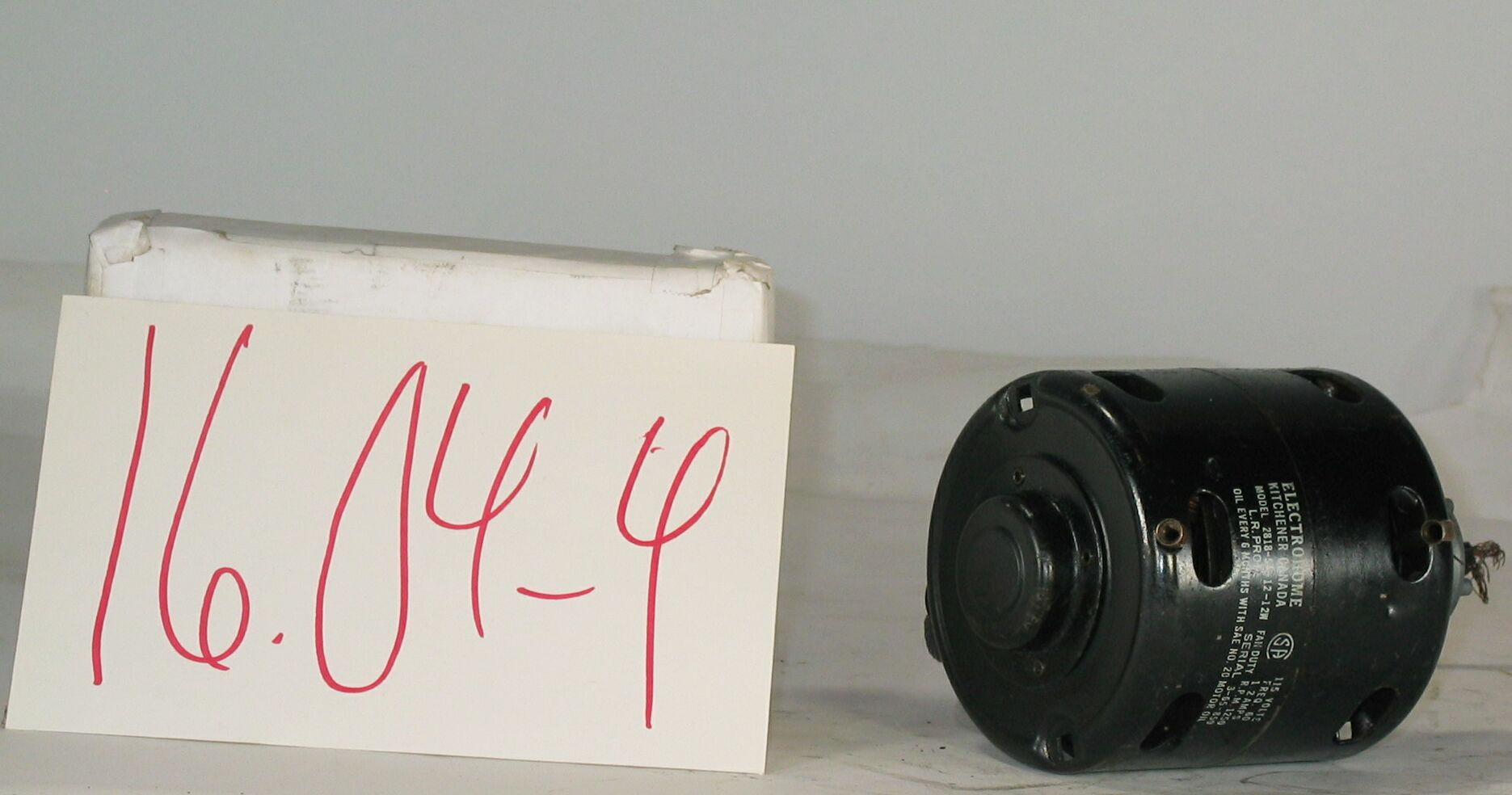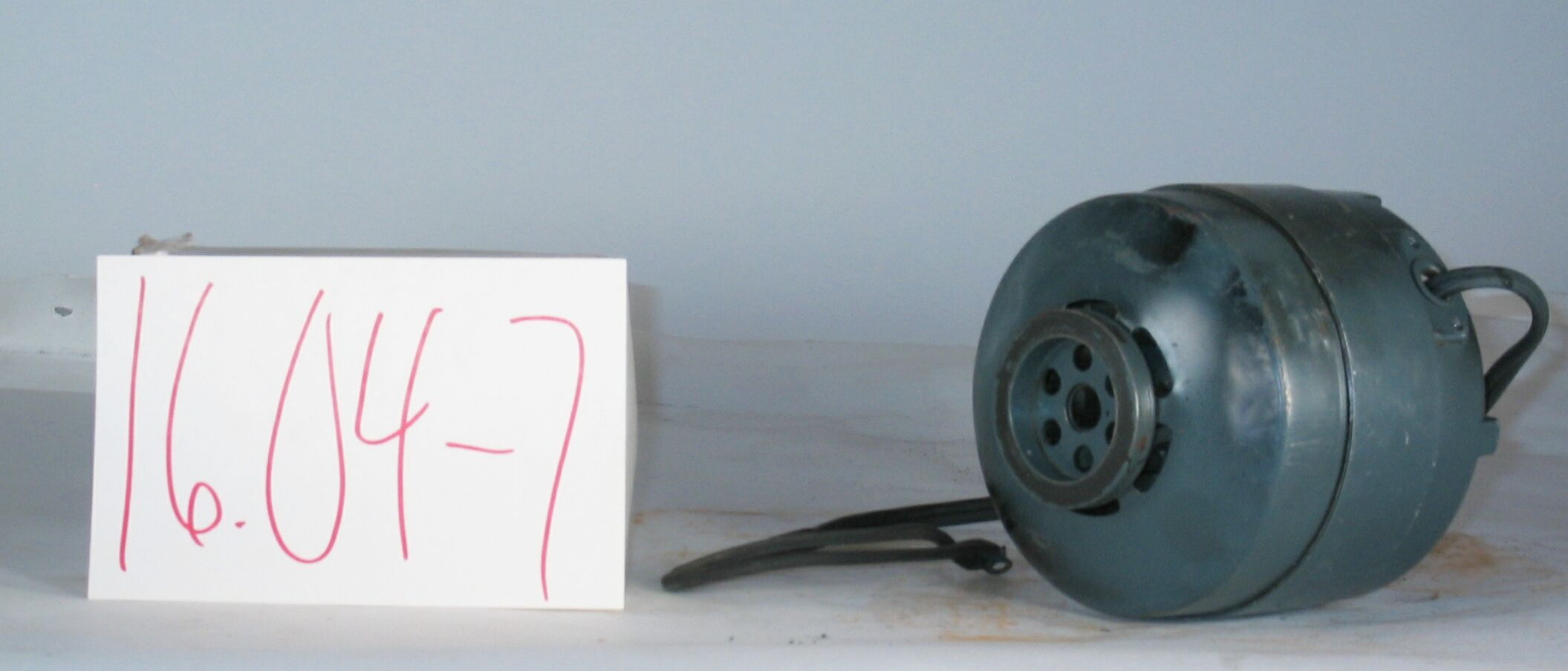16.04-2: Robins Myers 1952 Shaded Pole Induction Motor

| HHCC Accession No. 2006.188 | HHCC Classification Code: 16.04-2 |
|---|
Description:
A mid 20th century, 60 cycle, 1/36 th HP, Canadian made, shaded pole, single phase induction motor, engineered for use on small commercial refrigeration fan-coil cooling unit applications, commonly found in walk-in coolers in food stores throughout the early post W.W.II years and beyond. It would help to change the expectations of Canadians about what was at the their local food store, Robins Myers, Circa 1952.
Group:
16.04 Electric Motors - Single Phase, Shaded Pole and Universal
Make:
Robins Myers
Manufacturer:
Robins Myers of Canada Limited, Brantford
Model:
Type T1-AEZ1, Frame C32
Serial No.:
AH7931
Size:
9 x 4 ‘ round
Weight:
5 lbs.
Circa:
1952
Rating:
Exhibit, education, and research quality, illustrating the engineering and construction of an early mid century shaded pole, 60 cycle, induction motor specifically designed for small refrigeration, fan-coil cooling unit applications in the period.
Patent Date/Number:
Provenance:
From York County (York Region) Ontario, once a rich agricultural hinterlands, attracting early settlement in the last years of the 18th century. Located on the north slopes of the Oak Ridges Moraine, within 20 miles of Toronto, the County would also attract early ex-urban development, to be come a wealthy market place for the emerging household and consumer technologies of the early and mid 20th century.
This artifact was discovered in the 1950’s in the used stock of T. H. Oliver, Refrigeration and Electric Sales and Service, Aurora, Ontario, an early worker in the field of agricultural, industrial and consumer technology.
Type and Design:
Early mid 20th century, classic, shaded pole induction motor, engineered for fan duty on small refrigeration fan-coil evaporator applications 1/36 HP 110 volts, 60 cycle electrical junction box accommodating metallic flexible cable [cover not included] Sleeve bearings, oilers with rubber caps Ferro-magnetic body with light weight die cast end bells No base plate, designed for body strap mounting
Construction:
Material:
Special Features:
Accessories:
Capacities:
Performance Characteristics:
Operation:
Control and Regulation:
Targeted Market Segment:
Consumer Acceptance:
Merchandising:
Market Price:
Technological Significance:
Small, light weight and efficient, it is an example of the elegant and sophisticated, shaded pole motor technology that quickly emerged in Canada in the post W.W.II years, as a response to the market opportunities following frequency standardization and the rapid growth of the commercial refrigeration industry. The single phase alternating current induction motor has a public face of great simplicity - no commutator, brushes, governor nor switching mechanism to get it started, simply a field winding and solid state [squirrel cage] rotor mounted between two bearings. Its ‘shading pole(s)’ consisting of single turn of wire strategically placed around its pole face(s), is all that is required to start rotation. Yet the shaded pole induction motor is a marvel of early 20th century electrical design engineering. [See Reference No. Chapter XIII, P. 297]
Industrial Significance:
A marker of the ‘golden’, post W.W.II years of refrigeration manufacturing in Canada, which encouraged US electric motor manufactures, like Robins Myers, to establish facilities in Canada, as well as Canadian manufactures to enter the field ‘ see ID#313. Its low cost and unique speed-torque characteristics make the shaded pole induction motor ideal for small fan applications of 1/20th HP or less. A one-of-a-kind, just-in-time technology, it quickly found a special place in 20th century appliances and electrical equipment, where air circulation and ventilation where imperatives.
Socio-economic Significance:
Socio-cultural Significance:
The shaded pole induction motor quickly became an integral, often unobtrusive, component part of the appliances and equipment that increasingly invaded the Canadian home and place of business starting in the early 20th century. Typically custom engineered as component part of a larger piece equipment to ensure air circulation and ventilation, the shaded pole induction motor has enabled much and in so doing has change much of life for Canadians, as an essential part of our 20th and 21st century technological experience. Of equal significance is the ‘shaded pole synchronous motor’, which made possible the electric clock and a multitude of automatic time controlled devices throughout the 20th century [see for example Group 12.08 and 12.10 control devices]
Donor:
G. Leslie Oliver, The T. H. Oliver HVACR Collection
HHCC Storage Location:
Tracking:
Bibliographic References:
‘Fractional Horsepower Electric Motors’, Cyril Veinott, McGraw Hill New York, 1948, Chapter XIII, P.297 ‘Rewinding Small Motors’, Daniel Braymer and C.C. Roe, McGraw Hill, 1932 ‘A course in Electrical Engineering, Volume II, Alternating Current’, Chester Dawes, McGraw Hill, 1934, Starting single Phase Induction Motors, P. 362. ‘The Fractional Horsepower Motor and its Impact on Canadian Society and Culture’, G. Leslie Oliver, Material History Review, Vol. 43, Journal National Museum of Science and Technology, 1996.










